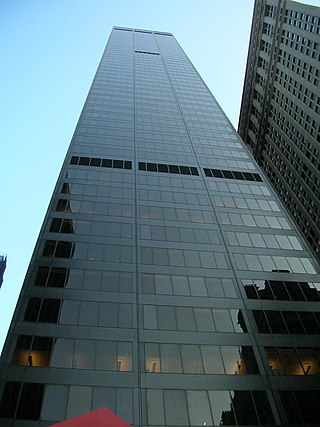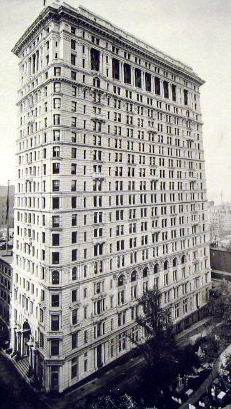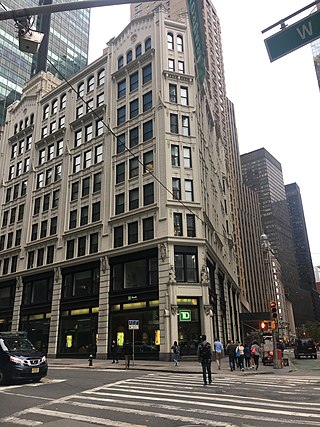
The Equitable Building is an office skyscraper located at 120 Broadway between Pine and Cedar Streets in the Financial District of Lower Manhattan in New York City. The skyscraper was designed by Ernest R. Graham in the neoclassical style, with Peirce Anderson as the architect-in-charge. It is 555 feet (169 m) tall, with 38 stories and 1.2 million square feet (110,000 m2) of floor space. The building's articulation consists of three horizontal sections similar to the components of a column, namely a base, shaft, and capital.

1 Wall Street is a mostly residential skyscraper in the Financial District of Lower Manhattan, New York City, on the eastern side of Broadway between Wall Street and Exchange Place. 1 Wall Street, designed in the Art Deco style, is 654 feet (199 m) tall and consists of two sections. The original 50-story building was designed by Ralph Thomas Walker of the firm Voorhees, Gmelin and Walker and constructed between 1929 and 1931, while a 36-story annex to the south was designed by successor firm Voorhees, Walker Smith Smith & Haines and built between 1963 and 1965.

140 Broadway is a 51-story International Style office building on the east side of Broadway between Cedar and Liberty streets in the Financial District of Manhattan in New York City. The building was designed by Gordon Bunshaft, of the firm Skidmore, Owings & Merrill, and consists of a mostly smooth black facade on a trapezoidal plot. It is approximately 688 feet (210 m) tall, with approximately 1.17 million rentable square feet (109,000 m2). It is known for the distinctive sculpture at its entrance, Isamu Noguchi's Cube.

The Daily News Building, also known as The News Building, is a skyscraper at 220 East 42nd Street in the Turtle Bay neighborhood of Midtown Manhattan in New York City. The original building was designed by architects Raymond Hood and John Mead Howells in the Art Deco style, and was erected between 1928 and 1930. A later addition was designed by Harrison & Abramovitz and built between 1957 and 1960.

The American Surety Building is an office building and early skyscraper at Pine Street and Broadway in the Financial District of Manhattan in New York City, across from Trinity Church. The building, designed in a Neo-Renaissance style by Bruce Price with a later expansion by Herman Lee Meader, is 388 feet (118 m) tall, with either 23 or 26 stories. It was one of Manhattan's first buildings with steel framing and curtain wall construction.

The New York Life Building is the headquarters of the New York Life Insurance Company at 51 Madison Avenue in the Rose Hill and NoMad neighborhoods of Manhattan in New York City. The building, designed by Cass Gilbert, abuts Madison Square Park and occupies an entire city block bounded by Madison Avenue, Park Avenue South, and 26th and 27th Streets.

60 Hudson Street, formerly known as the Western Union Building, is a 24-story telecommunications building in the Tribeca neighborhood of Manhattan in New York City. Built in 1928–1930, it was one of several Art Deco-style buildings designed by Ralph Thomas Walker of Voorhees, Gmelin and Walker for telecommunications in the early 20th century. 60 Hudson Street spans the entire block between Hudson Street, Thomas Street, Worth Street, and West Broadway.

The Empire Building is an office building and early skyscraper at 71 Broadway, on the corner of Rector Street, in the Financial District of Manhattan in New York City. It was designed by Kimball & Thompson in the Classical Revival style and built by Marc Eidlitz & Son from 1897 to 1898. The building consists of 21 stories above a full basement story facing Trinity Place at the back of the building and is 293 feet (89 m) tall. The Empire Building is a New York City designated landmark and is listed on the National Register of Historic Places (NRHP). It is also a contributing property to the Wall Street Historic District, a NRHP district created in 2007.

195 Broadway, also known as the Telephone Building, Telegraph Building, or Western Union Building, is an early skyscraper on Broadway in the Financial District of Manhattan in New York City. The building was the longtime headquarters of AT&T Corp. and Western Union. It occupies the entire western side of Broadway from Dey to Fulton Streets.

26 Broadway, also known as the Standard Oil Building or Socony–Vacuum Building, is an office building adjacent to Bowling Green in the Financial District of Lower Manhattan in New York City. The 31-story, 520-foot-tall (160 m) structure was designed in the Renaissance Revival style by Thomas Hastings of Carrère and Hastings, in conjunction with Shreve, Lamb & Blake. It was built in 1884–1885 as the headquarters of Standard Oil, at the time one of the largest oil companies in the United States, and expanded to its current size in 1921–1928.

108 Leonard, formerly known as 346 Broadway, the New York Life Insurance Company Building, and the Clock Tower Building, is a residential structure in the Tribeca neighborhood of Manhattan in New York City, United States. Built from 1894 to 1898, the building was constructed for the New York Life Insurance Company. Stephen Decatur Hatch created the original plans while McKim, Mead & White oversaw the building's completion. The building occupies a city block bounded by Broadway to the west, Leonard Street to the north, Lafayette Street to the east, and Catherine Lane to the south. It is a New York City designated landmark and is listed on the National Register of Historic Places.

49 Chambers, formerly known as the Emigrant Industrial Savings Bank Building and 51 Chambers Street, is a residential building at 49–51 Chambers Street in the Civic Center neighborhood of Manhattan in New York City. It was built between 1909 and 1912 and was designed by Raymond F. Almirall in the Beaux-Arts style. The building occupies a slightly irregular lot bounded by Chambers Street to the south, Elk Street to the east, and Reade Street to the north.

The Broadway–Chambers Building is an 18-story office building at 277 Broadway, on the northwest corner with Chambers Street, in the Civic Center and Tribeca neighborhoods of Manhattan in New York City. Completed by 1900 to designs by architect Cass Gilbert, the Broadway–Chambers Building was the first of several that Gilbert designed in the city.

The Adams Express Building is an office building at 61 Broadway in the Financial District of Manhattan in New York City. The building's primary frontage is on 57–61 Broadway, with additional frontage along 33–41 Trinity Place. Architect Francis Kimball designed the 32-story building for the Adams Express Company.

The Cunard Building, formerly the Standard & Poors Building, is a 22-story office building at 25 Broadway, across from Bowling Green Park, in the Financial District of Lower Manhattan in New York City. The Cunard Building was designed in the Italian Renaissance style by Benjamin Wistar Morris, in conjunction with consultants Carrère & Hastings. The Cunard Building's facade and principal first-floor interior spaces are New York City designated landmarks, and the building is also a contributing property to the Wall Street Historic District, a National Register of Historic Places district created in 2007.

The Mutual Reserve Building, also known as the Langdon Building and 305 Broadway, is an office building at Broadway and Duane Street in the Tribeca neighborhood of Manhattan in New York City. The 13-story building, constructed between 1892 and 1894, was designed by William H. Hume and built by Richard Deeves, with Frederick H. Kindl as chief structural engineer. It is just east of the Civic Center of Manhattan, and carries the addresses 305–309 Broadway and 91–99 Duane Street.

The Home Life Building, also known as 253 Broadway, is an office building in Lower Manhattan, New York City. It is in Manhattan's Tribeca and Civic Center neighborhoods at the northwest corner of Broadway and Murray Street, adjacent to City Hall Park.
5 Columbus Circle is an office building on the southeast corner of Broadway and 58th Street, just south of Columbus Circle, in the Midtown Manhattan neighborhood of New York City, New York, United States. Designed by Carrère and Hastings in the Beaux-Arts style, it is 286 feet (87 m) tall with 20 stories.

224 West 57th Street, also known as the Argonaut Building and formerly as the Demarest and Peerless Company Building, is a commercial building on the southeast corner of Broadway and 57th Street in Midtown Manhattan, New York City, just south of Columbus Circle. The building consists of two formerly separate structures, the A. T. Demarest & Company Building and the Peerless Motor Car Company Building, both used by automobile companies. Both structures were designed by Francis H. Kimball and erected by the George A. Fuller Company with similar Gothic Revival and Romanesque Revival architectural details.

218 West 57th Street is a building on 57th Street in Midtown Manhattan in New York City. It was designed by Cyrus L. W. Eidlitz in the French Renaissance Revival style, with an annex built to designs by Eidlitz and Andrew C. McKenzie. The building served as the headquarters of the American Society of Civil Engineers (ASCE) from 1897 to 1917.






















